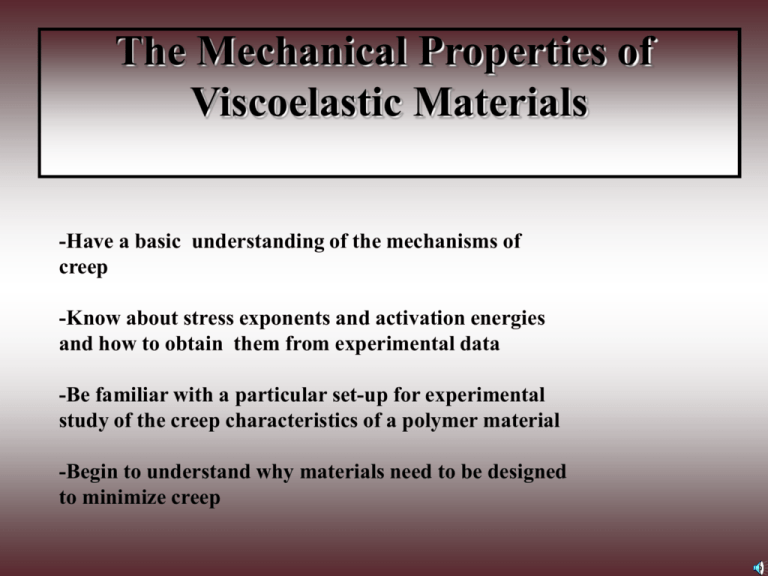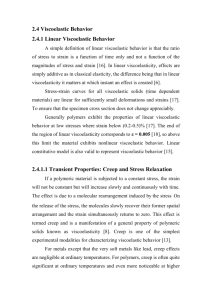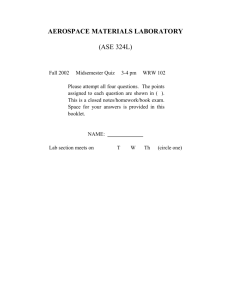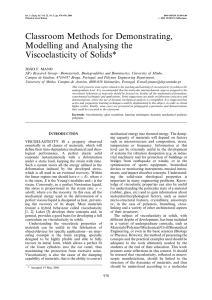Viscoelastic Analysis of Composite Materials
advertisement

The Mechanical Properties of Viscoelastic Materials -Have a basic understanding of the mechanisms of creep -Know about stress exponents and activation energies and how to obtain them from experimental data -Be familiar with a particular set-up for experimental study of the creep characteristics of a polymer material -Begin to understand why materials need to be designed to minimize creep Background For structural applications of materials such as bridges, pressure vessels, ships, and automobiles, the tensile properties of the metal material set the criteria for a safe design. Polymeric materials are being used more and more in structural applications, particularly in automobiles and pressure vessels. New applications emerge as designers become aware of the differences in the properties of metals and polymers and take full advantage of them. The analyses of structures using metals or plastics require that the data be available. Introduction When material is subjected to a stress that is greater than or equal to its yield stress, the material deforms plastically. When the stress is below this level, then in principle it should only deform elastically However, provided the temperature is relatively high, plastic deformation can occur even when the stress is lower than the yield stress. This deformation is time-dependent and is known as creep. Creep occurs faster at higher temperatures. Normal Trend of Creep Behavior During loading under a constant stress, the strain often varies as a function of time in the manner shown above Purpose of the Experiment The object of this experiment is to measure the tensile properties of a polymeric material at a constant strain rate on the home-made tension testing machine. Creep of other metals As a general rule, creep starts to become significant when the homologous temperature is greater than 0.4. Most metals do not suffer from creep at room temperature, since they have much higher melting points than solder. However, creep can still be a major concern when designing metallic components that have to function at high temperatures. An example of one such engineering challenge is in the design of turbine blades for use in jet engines. The blades in these enginescan be exposed to hot gases at up to about 1400°C. They are also under stress, as a result of the high centrifugal forces. These blades must withstand this environment without excessive creep, which would cause them to strike the turbine enclosure. Tensile Testing Machine The experiment is actually performed using a tensile testing machine. Teacher Different Teacher Do Not Disturb! Testing Going ON Teacher Before Load- Sample speciment me asured in 100th of an inch. Lo =445 parts of an inch After Load for a duration of 10 minutes- Sample speciment demonstrated effects of plasticity and elasticity. There was unnoticeable permanent deformation after cooling down from 149.2 F. Before Load- Sample speciment me asured in 100th of an inch. Lo =430 parts of an inch After Load for a duration of 30 minutes- Sample speciment demonstrated effects of plasticity and elasticity. There was noticeable permanent deformation after cooling down from 149.2 F. Creep Behavior Creep 40 Strain 35 30 25 20 Creep 15 10 5 0 0 500 1000 Time (sec) 1500 2000 What Makes Composite Materials Very Unique & Supernatural? Dr. Anastasia Muliana Ph. D, Structural Engineering and Mechanics, Georgia Institute of Technology, Atlanta, Georgia, May 2004 M.S., Civil Engineering, Georgia Institute of Technology, Atlanta, Georgia, August 1999 B. S., Civil Engineering, Bandung Institute of Technology, Bandung, Indonesia, October 1997, cum laude Viscoelastic Analysis of Composite Materials What does this all mean? • All materials exhibit some viscoelastic response. • Time dependent • Properties change with increasing or decreasing temperature Viscoelastic Phenomena Characteristics of thermo-mechanical and long-term behaviors of multi-layered composite materials • E-glass/Polyester pultruded composite material tested (tensile) • Measuring at 20%, 40%, and 60% ultimate tensile strength • Temperature: 0º F to 150 º F • Off-axis angle (Ɵ) of fiber: 0º, 45º,90º Creep and Relaxation ɛ ϭ stress strain time time Creep ϭ ɛ stress strain time Relaxation time • • • • • • • • • • • • Classroom Experiment Composite materials Viscoelastic behavior Tensile Force Applied Varying Temperatures Measuring devices Microsoft Excel TI-83/TI-84 graphing calculator TI-CBL 2 System Dial tool used in machine shops Thermometer Digital Clock Viscoelastic Creep Creep Strain (%) 1 0.9 Strain1 0.8 Strain2 0.7 Average 0.6 0.5 0 500 1000 Time (sec) 1500 2000 Acknowledgements & Credits







